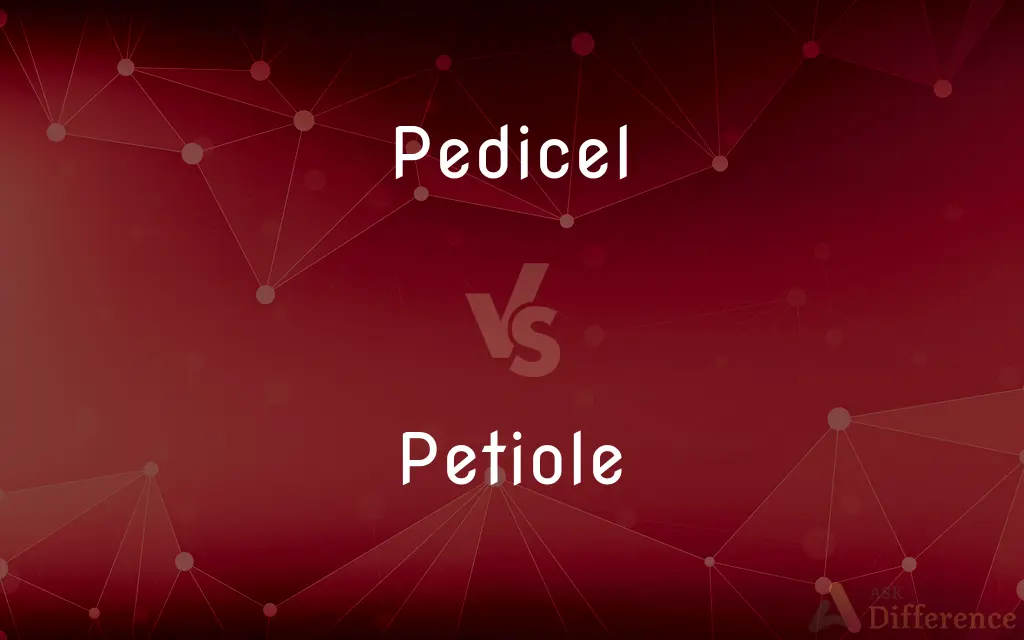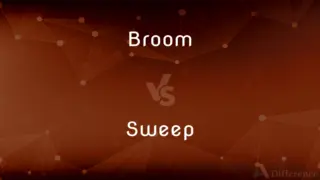Pedicel vs. Petiole — What's the Difference?
By Urooj Arif & Fiza Rafique — Updated on March 8, 2024
Pedicel connects a flower to its inflorescence, while petiole links a leaf to the stem.

Difference Between Pedicel and Petiole
Table of Contents
ADVERTISEMENT
Key Differences
A pedicel is a stalk that supports an individual flower in an inflorescence, holding it away from the main stem to give each flower adequate space and resources for pollination. On the other hand, a petiole is the stalk that attaches a leaf blade to the plant stem, enabling efficient photosynthesis by positioning the leaf in favorable light conditions and aiding in gas exchange and water movement.
The structure of a pedicel can vary greatly among different plant species, affecting the overall arrangement and appearance of the flowers in an inflorescence. Some flowers may have long pedicels, creating a loose and spread-out floral display, while others have short or nonexistent pedicels, resulting in tight, dense clusters of flowers. Conversely, the length and flexibility of a petiole can influence a leaf's orientation and movement, such as in response to sunlight (phototropism) or to minimize damage from wind.
In botanical terms, the pedicel is an integral part of the reproductive structure of a plant, as it helps in the positioning of flowers for optimal pollination by insects, birds, or other pollinators. The petiole, however, is crucial for the growth and health of the plant, facilitating the transport of nutrients and water between the leaf and the rest of the plant, as well as supporting the leaf in a position that maximizes photosynthesis.
Certain plants exhibit specialized adaptations in their pedicels or petioles. For instance, some species have pedicels that can move or twist to position the flower in the best possible orientation for pollinator attraction or seed dispersal. Similarly, some plants have petioles that are modified into tendrils or other structures that aid in support, climbing, or defense against herbivory.
The terminology and specific function of pedicels and petioles highlight the diversity and specialization in plant anatomy and physiology. While both structures serve as connections for different plant parts (flowers and leaves, respectively) to the main stem, their roles are distinct and tailored to the specific needs of the plant's reproductive and photosynthetic activities.
ADVERTISEMENT
Comparison Chart
Definition
The stalk attaching an individual flower to the inflorescence.
The stalk connecting a leaf blade to the plant stem.
Main Function
Supports the flower for optimal pollination and display.
Holds the leaf for efficient photosynthesis and gas exchange.
Variability
Length and flexibility affect the arrangement of flowers.
Influences leaf orientation and response to environmental factors.
Role in Plant
Part of the reproductive structure, aiding in pollination.
Crucial for growth, health, and photosynthesis of the plant.
Special Adaptations
May have movements for pollinator attraction or seed dispersal.
Can be modified into tendrils or other structures for support or defense.
Compare with Definitions
Pedicel
The stalk that supports an individual flower in an inflorescence.
Each flower in the bouquet was attached to its own pedicel.
Petiole
The stalk connecting a leaf to the stem, allowing for optimal sunlight absorption.
The plant's petioles angled the leaves towards the morning sun.
Pedicel
Can vary in length, influencing the flower's position for pollination.
The long pedicels of the plant made the flowers appear as if they were floating.
Petiole
Can have specialized forms for various functions.
In some vines, the petioles had evolved into coiling tendrils for climbing.
Pedicel
Plays a role in the aesthetic arrangement of flowers.
The varying lengths of pedicels contributed to the plant's sprawling floral display.
Petiole
Can be long or short, affecting leaf movement and positioning.
Wind rustled through the leaves, held aloft by sturdy petioles.
Pedicel
May possess adaptations for seed dispersal.
The pedicels twisted to release the seeds as they matured.
Petiole
May contain vascular tissues for nutrient transport.
The petiole served as a crucial conduit for water and nutrients between the leaf and stem.
Pedicel
Integral for flower orientation and spacing.
The dense clustering of the flowers was due to their short pedicels.
Petiole
Supports leaf adjustments for environmental responses.
The petioles bent, adjusting the leaves' angle as the sun moved across the sky.
Pedicel
A small stalk or stalklike part bearing a single flower in an inflorescence.
Petiole
(Botany) The stalk by which a leaf is attached to a stem. Also called leafstalk.
Pedicel
A support for a fern sporangium or moss capsule.
Petiole
(Zoology) A slender, stalklike part, as that connecting the thorax and abdomen in certain insects.
Pedicel
See pedicle.
Petiole
(botany) The stalk of a leaf, attaching the blade to the stem.
Pedicel
(botany) A stalk of an individual flower (or fruit, e.g., once fertilised); a stalk bearing a single flower or spore-producing body within a cluster.
Petiole
A narrow or constricted segment of the body of an insect; especially, the metasomal segment of certain Hymenoptera, such as wasps.
Pedicel
(mycology) A stalk of a fungus fruiting body.
Petiole
(entomology) The stalk at the base of the nest of the paper wasp.
Pedicel
(anatomy) A stalk-shaped body part; an anatomical part that resembles a stem or stalk.
Petiole
A leafstalk; the footstalk of a leaf, connecting the blade with the stem. See Illust. of Leaf.
Pedicel
(zoology) A narrow stalk-like body part connecting specific segments in certain insects and some other arthropods.
Petiole
A stalk or peduncle.
Pedicel
A petiole; the connection between the thorax and abdomen of an insect of suborder Apocrita.
Petiole
The slender stem that supports the blade of a leaf
Pedicel
The connection between the cephalothorax and abdomen of a spider.
Pedicel
The second segment of the antenna of an insect, between the scape and the flagellum.
Pedicel
(zoology) The segment of an antler that attaches to the head of a cervid.
Pedicel
A stalk which supports one flower or fruit, whether solitary or one of many ultimate divisions of a common peduncle. See Peduncle, and Illust. of Flower.
Pedicel
A slender stem by which certain of the lower animals or their eggs are attached. See Illust. of Aphis lion.
Pedicel
The ventral part of each side of the neural arch connecting with the centrum of a vertebra.
Pedicel
A small stalk bearing a single flower of an inflorescence; an ultimate division of a common peduncle
Common Curiosities
How does a petiole function in a plant?
A petiole connects a leaf blade to the stem, aiding in photosynthesis by positioning the leaf and facilitating nutrient and water transport.
What role does a petiole play in leaf orientation?
The petiole helps orient the leaf for maximum light absorption and can adjust the leaf's position in response to environmental factors like sunlight and wind.
Can the length of a pedicel affect a flower's appearance?
Yes, the length of a pedicel can greatly influence the spatial arrangement and overall appearance of the flowers within an inflorescence.
How does the variability in petiole length impact a plant?
Variations in petiole length can influence how a leaf responds to environmental conditions, such as optimizing photosynthesis and reducing damage from wind.
What is a pedicel in botany?
A pedicel is the stalk that attaches an individual flower to the inflorescence, supporting it for optimal display and pollination.
Are there specialized adaptations seen in pedicels?
Yes, some plants have pedicels with specialized movements or structures for pollinator attraction or efficient seed dispersal.
How does the structure of a pedicel contribute to pollination?
The structure of a pedicel, including its length and flexibility, contributes to effective pollination by positioning the flower in an accessible manner for pollinators.
Is the pedicel part of the plant's reproductive system?
Yes, the pedicel is a component of the plant's reproductive system, aiding in the positioning and support of flowers for successful pollination.
What is the significance of the petiole in plant health?
The petiole is crucial for plant health, as it supports the leaf in a position that maximizes photosynthesis and facilitates the transport of nutrients and water between the leaf and stem.
Can petioles have functions other than supporting leaves?
Petioles can have specialized modifications like turning into tendrils for climbing or serving other functions beyond just supporting leaves.
Share Your Discovery

Previous Comparison
Broom vs. Sweep
Next Comparison
Populist vs. LibertarianAuthor Spotlight
Written by
Urooj ArifUrooj is a skilled content writer at Ask Difference, known for her exceptional ability to simplify complex topics into engaging and informative content. With a passion for research and a flair for clear, concise writing, she consistently delivers articles that resonate with our diverse audience.
Co-written by
Fiza RafiqueFiza Rafique is a skilled content writer at AskDifference.com, where she meticulously refines and enhances written pieces. Drawing from her vast editorial expertise, Fiza ensures clarity, accuracy, and precision in every article. Passionate about language, she continually seeks to elevate the quality of content for readers worldwide.
















































